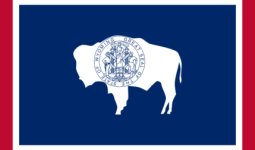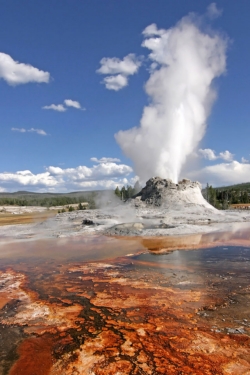Wyoming
Wyoming is a state in the mountain region of the Western United States. It is bordered by Montana, Idaho, and Utah to the west; Montana to the north; South Dakota and Nebraska to the east; with Colorado and Utah to the south.
- ABBREVIATION: WY
- NICKNAME: The Equality State
- POPULATION: 582,658 (2013 est.)
- CAPITAL: Cheyenne
- STATE BIRD: Western Meadowlark
- STATE FLOWER: Indian Paintbrush
- AREA: 97,814 sq. mi.
- TIME ZONE: Mountain
- ENTERED UNION: July 10, 1890
- ALTITUDE: High, 13,809 ft. Gannett Peak
- CLIMATE: Mostly dry, with severe winters and fairly cool summers. Light summer rain.


Here lay the great highway of the Old West. Much of the state is scrub and sage, a high land of thrusting mountain ranges, rolling plains and sloping basins. Past Rattlesnake Hills and into legendary South Pass went the old Oregon and California trails. In some places, the deep ruts worn into the baked soil by the ironbound wheels of countless wagon trains can still be seen, a section of the pass, and its historic wheel ruts, was declared a National Historic Landmark in 1966. Through Wyoming went the Pony Express, the first trans-continental telegraph line and the rails of the Union Pacific.
Although oil-refining, sugar beet processing, and coal mining are important to modern Wyoming, the state retains much of the atmosphere of the Old west. In the countryside graze more than 350,000 sheep, down from the more than 3.7 million sheep reported back in the 1940’s, but still a vital part of the state’s economy. Due to the recent years of drought, the larger ranches have reduced their numbers of cattle, however, with just over a million cattle in stock, cattle and sheep out-number people in Wyoming by almost 3-1. Yes, it’s still the Old West in Wyoming, with plenty of open space, horses, cowboys, cattle, sagebrush, blue skies, and clean air; Wyoming still stirs up images of the frontier days of the westward expansion.

For tourists, Wyoming primarily means natural geysers, protected wildlife, and the roaring cataracts of Yellowstone, the oldest and largest national park in the United States. Yellowstone spans an area of 3,468.4 square miles, comprising lakes, canyons, rivers and mountain ranges; it is primarily located in Wyoming. Yellowstone National Park contains some of the strangest and most interesting geological features found anywhere in the world. Declared a National Park on March 1, 1872, it continues to draw millions of tourists from every corner of the planet. Another popular tourist attraction is the annual ‘Frontier Days’ held every summer in Cheyenne Wyoming. Cheyenne Frontier Days is a 10-day festival of non-stop excitement, featuring the world’s best rodeo action and Western entertainment.
FUN FACTS:
- The famous Teapot Dome scandal, which blackened President Harding’s administration, concerned oil leases in Wyoming and California. It took its name from the shape of a rock formation above the oil reserves in Wyoming.
- Cody, Wyoming, is named for ‘Buffalo Bill’ Cody.
- Butch Cassidy’s Wild Bunch gang lived in and around Kaycee, Wyoming, on the Powder River.
- Wyoming is called the Equality State because it was the first state to give women the right to vote, granted in 1869 when it was still a territory.
- The horse on Wyoming’s license plate is named ‘Old Steamboat’ in honor of a legendary bucking bronco that no one could ride.
- ‘Devils Tower‘ was named the country’s first national monument by President Roosevelt in 1906. It is a sacred site of worship to many Plains Indians, who know it as ‘Bears Lodge’.
